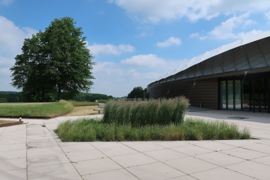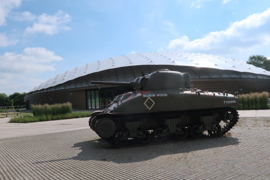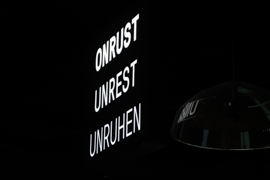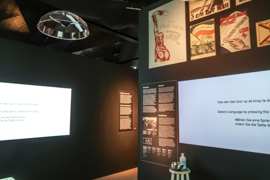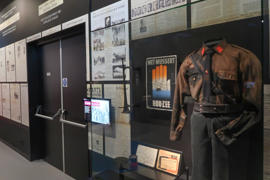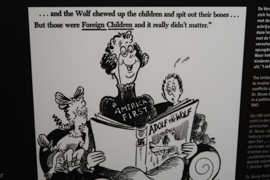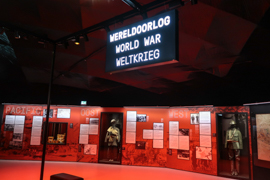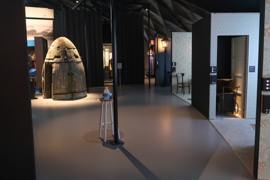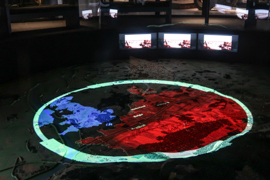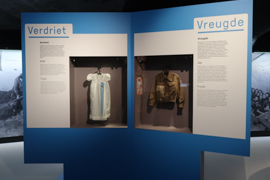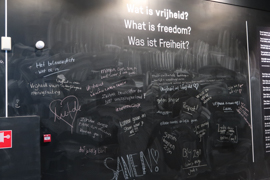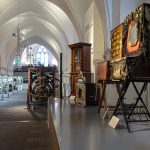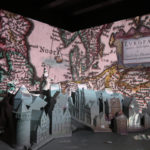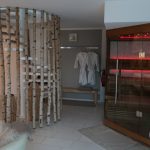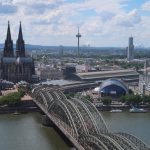Dutch Freedom Museum
15 Euro
Flyctory.com Pros
- Very good museum
- Great perspective to focus on freedom instead on WWII only
- A lot of original exhibits
- Air-raid shelter simulation
A very interesting rebranding: when I started to explore museums in the nearby Netherlands, the Dutch Freedom Museum in Groesbeek has still been called Bevrijdingsmuseum – Liberation museum. With its 2019 rebranding to Vrijheidsmuseum, it is putting a stronger focus on the importance of freedom. One more reason to visit the place and share my thoughts with you.





Dutch Freedom Museum – Location & Admission
The Freedom Museum is located in the North of Groesbeek, a city not too far away from Nijmegen. The easiest way to get there is by car – the museum also offers a sufficient number of free parking lots. However, public transport (buses) are possible as well.
The museum is opening daily from 10:00 to 17:00 hrs. On Sundays, the doors open at noon. Adult admission to the museum is 15 Euro. The museum does accept the Dutch Museumkaart, though.

Dutch Freedom Museum – The Visit
The whole documentation of the museum is in Dutch, German (due to the close proximity of the border to Germany) and English. Your visit is split into different sections, in which the museum illustrates the topic with quite an impressive number of exhibits – very often original ones. World War II is the main topic of the museum, which still shows the character of a Liberation Museum. You see and feel the rebranding at multiple stages. One of them is right at the beginning of your visit: You starts with a movie about the importance and meaning of freedom, before you head into the museum. The staff was very attentive and had information in all three languages.






The museum is focused on the German occupation, especially in the first section. The Dictatorship of the Nazis is one of the key topics – there are even some original exhibits like a huge flag which was originally fixed at a monastery in Nijmegen. You also learn how the Nazis tried to separate the Jews and what the occupation and the war meant for the people in the Netherlands and in Germany.















One of the most impressive parts of visiting the museum was experiencing a (too short) air raid in an air raid shelter. Especially in this part of the museum, the Freedom Museum is not only looking on what happened to the Dutch people, but also to the Germans on the other side of the River Rhine, e.g. in the city of Kleve. In this part of the museum, they do an excellent job illustrating the Operation Market Garden – one of the key military operations which finally lead to the defeat of Germany.














How War Changes Life
What I really liked about the museum is how war changes the life of people. In the second picture below, you for example see a not too uncommon wedding dress at that time. The material of the bride’s dress was made of the cloth of a parachute. The exhibition is also about death, rebuilding destroyed cities – and then, later, fighting for peace nowadays. I liked the idea that people could simply write down what freedom means to them and how much it is worth to fight for it.















Dutch Freedom Museum – Services
Close to the reception area, there is a museum cafe, which just had a couple of tables due to social distancing measures.


There is also a small souvenir shop area. They are not only selling books and videos, but also some models and building brick sets there.



Dutch Freedom Museum – My View
I feel talking too much about World War II and what happened over 70 years ago should still be present in your minds. Nonetheless, I feel that the approach the Dutch Freedom Museum is taking is very valuable. They try to connect what happened during WWII with our nowadays life. A tough task – but I feel they did a great job. Bad luck that this place is not too well-known. It is absolutely worth a visit!
Netherlands Top Pick!
Here are all postings related to the Netherlands I marked as Top Pick!:

After featuring the rematch of the Netherlands and the Faroe Islands in Almere, Netherlands, I decided it was the better ...

During my most recent trip to Utrecht, I unfortunately did not have too much time to explore the city. Apart ...

I rarely run into rock bands from the Netherlands. The more, I was happy to receive the promo of the ...

A Hilton Hotel just an hour away from my home coming with a special kind of architecture and competitive prices? ...

Roberta John Joni Mitchell is a Canadian-US-American singer-songwriter, who majorly did folk and pop music in her career. She has won ...

What a massive impact weekend for the wonderful Dutch artist Sylvia Aimee: on 30th June 2023, the country-pop artist is ...

The website states that the Nederlands Spoorwegmuseum (also: Het Spoowegmuseum) is the best train station in the Netherlands. In fact, the ...

One of the ten concerts I visited of the Weird Al Yankovic European Tour 2023 was at the TivoliVredenburg in ...

Especially when I visit large places, which demand and deserve a major number of pictures, it may take quite some ...

Quite a while ago, I took a trip to Arnhem in the Netherlands to explore the rich WWII history of ...

Covid-19 felt to be a good opportunity for Esa Holopainen to go solo. Instead of releasing new stuff with Amorphis, ...

The National Monument Camp Vught - or Konzentrationslager Herzogenbusch, which has been the German name during the Nazi era - is ...

Even though the Netherlands capitulated against Germany just after a few days under attack during World War II, they have ...

In 1944, the 101st Airborne Division, called Screaming Eagles, landed North of Eindhoven in the Netherlands. As part of the Operation Market ...

How could a visit of Rotterdam be complete without having a look into the harbor? The Port of Rotterdam is ...

The blue and white porcelain from Delft is a globally well-known brand. While my wife and I spent time in ...

If you are on a city trip, you likely fancy to buy a multi-attraction ticket. There are global companies like ...

The Louwman collection, nowadays driven by the son of founder Pieter Louwman, Evert, is a private collection of oldtimer cars ...

There are not too many museums about African history and culture on the European continent. Thus, the Afrika Museum in ...

I am not really a person who is into paintings and other graphic arts, but without spoiling this review too ...

During a July 2020 trip through the Netherlands, I had two nights at the NH Collection Hotel Eindhoven Centre, right ...

A museum for home computers feels like a technical reflection of my biography. I personally started with an Atari 800 ...

One for the most positive surprises of my early July 2020 trip to Amsterdam and Eindhoven was the Channel Museum ...

With the Covid-19 situation easing and travel restrictions more and more lifted, I was happy to have a trip to ...

At least in the Cologne area where I live, Castle Arcen in the Netherlands, close to the German border, is ...

Some of my hobbies are travelling, civil aviation incl. historic planes and hotels - so having a plane which has ...

10th January 2020 had a couple of interesting album releases. DeWolff from the Netherlands are playing an interesting mix of ...

While there is a boom in local modern country music in the United Kingdom, there is still quite some development ...

Just one week after I had seen Lauren Jenkins together with Jilian Jacqueline and Gary Quinn at the YUCA in ...
Travel – Cologne Region Top Pick!s
Here are all travel postings of the region around Cologne, which received a Top Pick! rating:

The 2025 Rock of Ages shows in Cologne (I visited all of them...) gave me the opportunity to have a closer ...

I have stayed at the Mercure Hotel Düsseldorf Ratingen a couple of times before my night in June 2024. However, ...

Meeting with friends in Troisdorf between Bonn and Cologne in the evening and relaxing at the Wellnest private spa Bonn ...

My trip to the handball matches at the EHF Euro 2024 preliminary round matches in Berlin did not feel being ...

Just as it felt convenient to stay somewhere closer to the office where I work, I had a night at ...

As part of my overnights bridging the night between two mandatory days at the office in Cologne, my last stay ...

Just a week after I stayed at the Mercure Cologne City Friesenstrasse, I tried out another hotel of the Accor ...

The name of the German city of Wuppertal in the Bergische Land region near Cologne is indeed a perfect fit ...

The Wasserturm in my home town Cologne is indeed one of the most iconic hotels of the city. Literally, the ...

Sea Life runs several outlets in Germany. One of them is in Oberhausen in the Ruhrgebiet region. With 5000 inhabitants ...

I had a couple of private spa experiences with my wife already, like the MyWellness in Cologne or the Pure ...

Saving my Melia frequent traveler points and doing some research for Flyctory.com were two really good reasons to try out ...

The museum at the Schwelmer Straße 41 is not exactly at birthplace of Wilhelm Conrad Roentgen - but it is just a ...

Okay, I have to give in from the very beginning: I love my home town Cologne - and this my ...

Germany between World War II. - this is roughly the mission of the House of the History of the Federal ...

One of the architectural witnesses of the industrial heritage of the Rhein-Ruhr Region in Germany are definitely the gasometers. These ...

Trying out another hotel brand: after I had stayed at quite a bunch of Premier Inn Hotel locations in England ...

Even though it is a some 50 kilometer drive from Cologne to Gummersbach, the VfL Gummersbach is not only the ...

Located right at the River Rhine, the Hyatt Regency is one of the most iconic and also one of the ...

The hotel situation at Cologne / Bonn Airport used to be quite bothering. There used to be a single hotel ...

Especially after all the Covid-19 restrictions, my wife and I were really looking forward to two relaxing hours in a ...

The story why I felt I had to visit the Bergisches Museum für Bergbau, Handwerk und Handel - the Bergisches ...

Since late October 2020, restaurants in Germany are not allowed to open as a pandemic lock-down measure. However, take-away services ...

Cologne Cathedral is the key attraction of my home town Cologne, of course (it is even one of Germany's very ...

After we visited a couple of hotels in Bonn, we finally wanted to check out the only five star one ...

The Rheinturm - or Rhine Tower - is definitely one of Dusseldorf's most iconic viewpoints. During a recent stay at the ...

A Calculation Museum? Sounds like a place for die-hard nerds - but the Arithmeum in Bonn is really a popular ...

You may know Mönchengladbach (or: Moenchengladbach) for soccer, likely. However, the city hosts one of the most remarkable Star Wars ...

Though it just processes about a half of the number of passengers of Munich Airport and even just a third ...

Wuppertal in the Bergisches Land region Northeast of Cologne hosts a very special attraction for train and rail enthusiasts: the ...

Lindlar, a minor Eastern suburb of Cologne, hosts one of two open-air museums driven by the regional Rhineland authority LVR ...

Bergisch Gladbach, a 110,000 inhabitant city East of Cologne, is a traditional location for the production of paper. While nowadays, ...

Another six months have passed - the first full half year of Flyctory.com's existance. After I did the Very Important ...

Located North of Cologne, the "Wildpark Tannenbusch" offers a nice way to spent your free time with your family, enjoying ...

